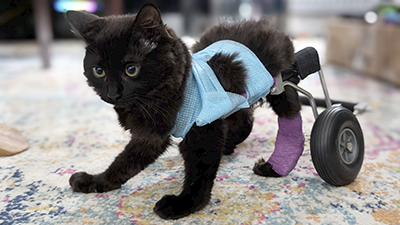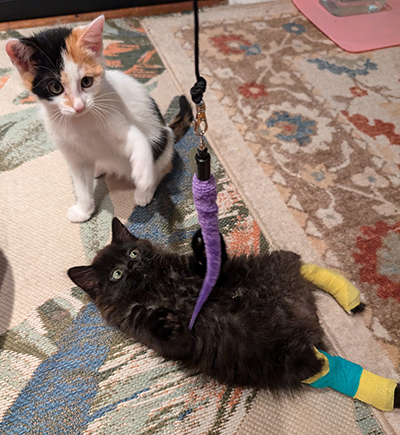You’re Thinking About Adding to Your Family!
That’s Great!
Adopting a kitten is a long-term commitment.
Cats can live well beyond 10 years, easily to 15 and some live into their 20s. A very few have even gotten to 30! Please make sure you’ve considered the cost and how it will affect your budget over a decade worth of food and litter costs, annual wellness exams and the amount of time and love your new friend is going to require before moving forward.
If you’re not sure you’re ready for a rambunctious kitten, adopting an older cat may be for you! Their personality is already formed so if you want a lap cat, youll know what youre getting up front. Adults are mellower, but still have the desire to play, just not usually at 2AM when youre trying to sleep. If we’re called Kitten Associates, why would we suggest you adopt an adult when K.A. doesn’t usually have adults available for adoption?
Answer: Adults are often overlooked because kittens are so very cute - even though kittens have grown to their full size by the time they are less than a year old. Adult cats can’t compete with that, but kittens require a lot more care than adults do. We would rather you adopt the RIGHT cat for you even if we don’t have that cat! We can, however, help you find what you’re looking for because ultimately EVERY cat that needs a good home matters to us. It doesn’t matter if you adopt from us, as long as you adopt from a Shelter or Rescue Group!
AND never take on a Free kitten from Craigslist or buy one from a store (see our costs, at right, to see how much that FREE kitten will end up costing you).
Getting a New Kitten Means...
Doing Some Shopping!
- A new or freshly washed out cat carrier
(please bring with you to pick up your new kitty!) - A litter pan, uncovered-only, with no litter pan liner. Cats dont like to be confined when they use their pan and liners bother them. Please use ONLY UNSCENTED litter.
- Stainless steel or ceramic food and water bowl (as long as the glazing does not have lead). Plastic or melamine pet food dishes hold bacteria in them no matter how well you clean them. They can also cause Feline Acne.
- Toys! Cats need stimulation and play time. It helps keep them happy, healthy and from using YOU as a toy! NEVER use your hands as a toy or your little cat will grow up into a big cat that can bite you when you try to pet her! We suggest a variety of different types of toys. Fake mice, small balls, long string-wand based toys, as well as feather-attached-to-string toys and catnip toys that are large enough for your kitty to hug and bite.
- Scratching posts and pads. A VITAL tool for keeping your precious belongings from being shredded. Provide a vertical scratching surface either made of red cedar, carpeted or covered with sisal that is over 31 tall and is VERY STURDY. Your cat will need to be able to comfortably stand and stretch out completely to unknot those muscles and to sharpen claws. Also get at least one, if not more, horizontal and/or angled pad-type corrugated cardboard cat scratchers.
- What about treats? Cats don’t really need treats, but if you want to give them something yummy, you can buy dehydrated chicken or salmon, no beef, treats that are NOT dry kibble, but actual pieces of dried meat. Most pet shops carry a variety of kinds. You can also give your kitty, RAW, uncooked, turkey or chicken giblets. The RAW, uncooked neck of poultry is great for cleaning cats teeth. You can also feed RAW uncooked, drummies or chicken wings. Gnawing keeps your cat's teeth strong, too.
- Kitten or Cat Food. Our cats are fed a raw, fresh meat diet starting at 8 weeks of age. It's the most wholesome and appropriate food to help them live a long, vital life.
A Good Diet for a Long, Healthy Life
One of the reasons why Kitten Associates is the New Breed of Cat Rescue is partially due to what we feed our foster kittens. They don’t get dry food—ever. Nor do they get food that has inappropriate ingredients like grains, fillers, pea flour and more.
Our policy is simple: NO DRY FOOD, EVER. NO “Prescription or Science Diets canned OR dry.”
Why are we so picky?
Cats are “obligate” carnivores, meaning they MUST eat ANIMAL PROTEIN as their main source of energy-just as humans depend on carbohydrates. The more processed (cooked, baked, grilled, dried) their food is, the less likely there are ANY good quality proteins in their food. That's why Raw is the way to go.
Think of it this way: If your cat lived outdoors, with no humans to feed her, what would she eat? She would eat 1: VARIETY, bugs, small rodents, birds. 2: She would eat them RAW, not cooked or processed. She would utilize the the bones and skin to clean her teeth. She would get moisture from the flesh, as well as vital nutrients. That's why we feed a variety of raw proteins, mimicking what natures does. It just makes sense.
The good news is this diet is commercially available, just like any other cat food. It comes frozen, in serving sizes, or freeze-dried, that you add warm water to. You can even make your own, which is fun because that way YOU control what goes into your cat's food. It's very cost-effective and we can show you how to do it.
We never leave you in the lurch, to figure it out on your own. All adopters get our Feeding Guidelines, which are chock full of links to where you can get your raw food. We also supply all adopters with samples of the same food your new cat or kitten has been eating while they are living in our foster homes.
Not convinced? How about this: Your cat on a raw diet, won't use the litter pan much and THEIR STOOL WILL HAVE NO FOUL ODOR! How's that for awesome?
*Based on guidelines developed by the Feline Nutrition Education Society https://www.feline-nutrition.org

Spay/Neuter Policy
We only adopt out cats that have been spayed or neutered prior to adoption. Shelters are overflowing with unwanted pets and millions of healthy cats are euthanized due to overcrowding issues. We will never add to that problem by allowing any of our foster cats to reproduce.
We support juvenile spay/neuter of our adoptable kittens who are healthy and over 8 weeks of age. If you’d like to know more about why it’s safe and effective to do early-age S/N, please visit this helpful link from the ASPCA: https://www.aspca.org/pet-care/spayneuter/early-spay-neuter.html
Declawing is NOT an Option.
Thinking about declawing your cat? Think again! Declawing is not the removal of a portion of a claw. Instead, it is the surgical amputation of the first joint of the cat’s toes. Whether this procedure is accomplished with a scalpel, a guillotine-type cutter or a laser, it is major surgery, and not to be undertaken lightly. In countries outside the USA, it’s actually illegal!
Declawed cats have a much higher incidence of litterbox aversion, and biting too!
Here’s some helpful information about the dangers of declawing and some tips on how to encourage your new kitty to enjoy sharpening her claws in ways that don’t end up ruining your furnishings. https://www.declawing.com
How to trim kitty’s claws: https://www.catscratching.com/htmls/article.htm or use SoftPaws https://www.softpaws.com or scratching posts effectively: https://www.catscratching.com








